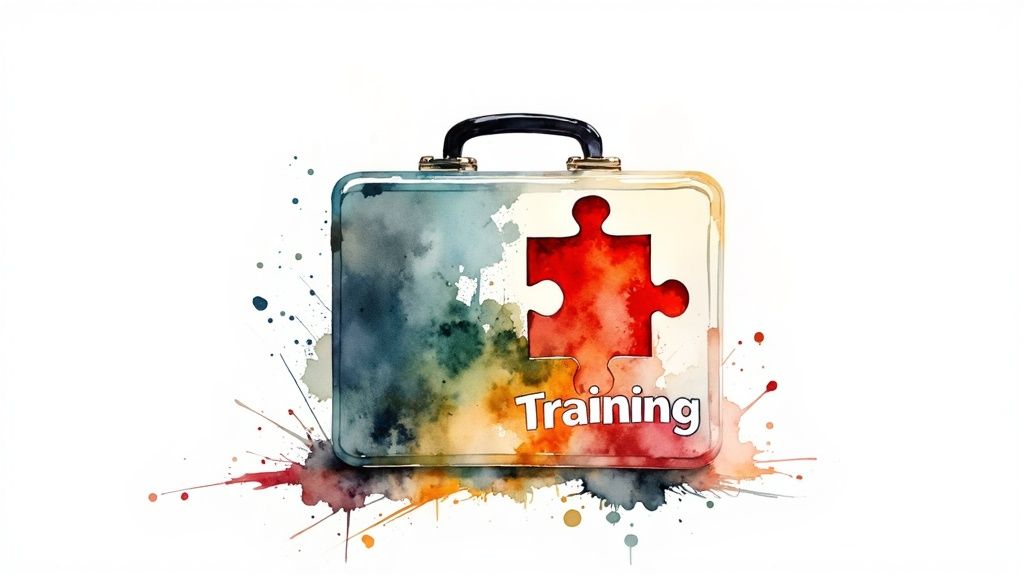Your Training Is a Waste of Money. Here's How to Fix It.
Discover essential training survey questions to gather valuable feedback and improve your programs. Read our expert tips now!
Posted by
Related reading
Your Staff Engagement Survey Is a Useless Vanity Metric
Discover effective staff engagement survey template ideas for 2025. Boost your team’s involvement and gather meaningful feedback easily.
Let's be honest. Most corporate training is expensive theater. You spend a fortune, your team loses a day pretending to listen, and absolutely nothing changes. They get stale pizza, you get a check in a box, and the problems you were trying to solve are still there Monday morning, mocking you. You feel like you did something productive, but the numbers don't move. Why? Because you're measuring smiles, not impact. You're asking if the coffee was hot, not if the new skills will stop a key account from churning.
This isn't a fluffy guide on the "importance of feedback." This is an arsenal of battle-tested training survey questions used to stop burning cash and start building teams that can actually execute. Ignore your customers, and you’ll be lucky to survive the quarter. The same goes for your team.
For a broader look at building a system to gauge if your training is working, explore this guide on how to measure training effectiveness. But for now, let's get to the questions that cut the crap.
1. Overall Training Satisfaction Rating
Look, before you get fancy, you need a pulse check. This question is your baseline, your North Star. Did you hit the mark, or did you completely miss? It’s a simple "On a scale of 1-5, how would you rate this training?" It gives you a high-level snapshot before you start dissecting the patient.

Why It’s Non-Negotiable
This is your frontline KPI. Without a universal metric, you’re flying blind, comparing apples to oranges across different programs. Big players like Google and Coursera use this to benchmark everything. It’s not about making people happy; it’s about establishing a baseline for quality so you can prove which programs are actually working.
The takeaway: A low score is a fire alarm; a high score gives you permission to dig deeper.
2. Relevance to Job Role Assessment
An entertaining training session that isn’t relevant to someone’s job is just an expensive day off. This question cuts through the fluff: "How relevant was this training to your daily work?" It’s the difference between arming your team with sharper spears and just giving them something shiny to hold. If the answer isn't "extremely relevant," you just burned a pile of cash.

Why It’s Non-Negotiable
Relevance is the bedrock of ROI. Amazon and Salesforce don’t offer generic training; they offer hyper-specific, role-based modules because they know relevance drives application. If your team can’t connect the dots between the training room and their to-do list, the knowledge evaporates the second they walk out the door.
The takeaway: If it’s not relevant, it’s not training; it’s a distraction.
3. Knowledge Gain Self-Assessment
Did they actually learn anything, or just enjoy the free coffee? This question cuts to the chase: "On a scale of 1-5, rate your knowledge of [specific skill] before this training. Now rate it after." The gap between those two numbers is your proof of impact. It’s a simple way to measure the perceived shift from "I have no idea" to "I can do this."

Why It’s Non-Negotiable
This is your direct line to perceived ROI. If attendees don't feel smarter or more capable, they won't even try to apply the new skills. Microsoft uses this to validate that perceived learning aligns with actual performance. It separates a training budget that's an investment from one that's just an expense. For a deeper dive into survey design, you can learn more about how to create a questionnaire on backsy.ai.
The takeaway: If people don’t feel smarter, your training failed, regardless of what a test says.
4. Trainer/Facilitator Effectiveness Evaluation
The most brilliant content in the world is useless if delivered by a monotone robot reading from a slide. The trainer is the lead actor in this expensive performance. This question isolates their impact: "Rate the trainer's ability to be engaging and knowledgeable." A poor facilitator can sink a perfect program. This tells you if your instructors are assets or liabilities.

Why It’s Non-Negotiable
Ignoring trainer feedback is like casting a movie without an audition. You're betting your entire budget on someone who might not be able to deliver their lines. GE's legendary Crotonville and Apple University obsess over instructor quality because they know a great trainer doesn’t just present information; they inspire action.
The takeaway: A bad trainer will kill good content every single time.
5. Content Quality and Clarity Assessment
A charismatic trainer can’t save a program built on confusing, disorganized, or irrelevant content. This is your quality control on the "what": "The training content was well-organized and easy to follow (Agree/Disagree)." This is where you find out if your beautifully designed slides were actually just corporate hieroglyphics.
Why It’s Non-Negotiable
Flawless delivery means nothing if the content is junk. This is your sanity check. Online platforms like Coursera and LinkedIn Learning live and die by this feedback. They treat content clarity as a core product feature, because if the material is confusing, learners drop off. If your content isn’t clear, your training is just an expensive, well-intentioned waste of time.
The takeaway: Great delivery of bad content is still bad training.
6. Likelihood to Recommend (Net Promoter Score)
Satisfaction is polite. Advocacy is powerful. The NPS question—"On a scale of 0-10, how likely are you to recommend this training to a colleague?"—is unforgiving, and that's why it's so valuable. It tells you if you created an experience people will champion or a session they’ll warn others to avoid. It measures whether they'd put their own reputation on the line for your program.
Why It’s Non-Negotiable
NPS cuts through the BS. A high score means you've created internal champions. Deloitte University tracks NPS to find the programs that generate true evangelists, not just attendees. Ignoring this is like ignoring the difference between a passive customer and a raving fan. One accepts, the other recruits. If you need a framework for this, you can learn how to improve NPS by turning Detractors into Promoters on Backsy.ai.
The takeaway: A low NPS means your training has a bad reputation you don't even know about yet.
7. Training Logistics and Environment Evaluation
You can have the best content and trainer on earth, but if the room is freezing or the webinar software keeps crashing, the training is dead on arrival. This question audits the experience itself: "Rate the training facilities, technology, and scheduling." It’s about removing every stupid, preventable barrier to learning.
Why It’s Non-Negotiable
Bad logistics are a silent killer. They signal disrespect for your team's time and focus. Marriott meticulously schedules training around hotel operations for a reason—disruption kills engagement. Ignoring logistics is like building a race car with square wheels. It doesn't matter how great the engine is; you're not going anywhere. For more on this, check out this guide to post-event survey questions on backsy.ai.
The takeaway: If the environment sucks, the learning stops.
8. Planned Application and Behavior Change Intentions
Satisfaction is nice. Application pays the bills. This question forces a commitment: "What are the top three actions you will take in the next 30 days based on this training?" It’s the bridge between a good idea and a real-world action. It turns a passive event into an active plan.
Why It’s Non-Negotiable
This is your direct line to potential ROI. It shifts the conversation from "I liked it" to "Here's what I'm going to do with it." Accenture integrates action plans into its programs and shares them with managers to create an instant accountability loop. Without this commitment, great ideas die in the notebook.
The takeaway: If there’s no plan to apply it, the training was just a conversation.
Training Survey Questions Comparison Matrix
| Item | Implementation Complexity 🔄 | Resource Requirements ⚡ | Expected Outcomes 📊 | Ideal Use Cases 💡 | Key Advantages ⭐ |
|---|---|---|---|---|---|
| Overall Training Satisfaction Rating | Low - simple standardized scales | Low - quick surveys | Quick snapshot of participant satisfaction | Broad training sessions needing immediate feedback | Easy to answer, measurable ROI, enables benchmarking |
| Relevance to Job Role Assessment | Medium - may need role segmentation | Medium - requires role-specific analysis | Insights into training transfer potential | Role-targeted programs aiming at practical application | Directly correlates to on-the-job performance, improves targeting |
| Knowledge Gain Self-Assessment | Medium - retrospective pre-post | Medium - combines before/after ratings | Measures perceived learning and competence | Skill-based training requiring evidence of knowledge gain | Demonstrates learning impact, easy single-survey completion |
| Trainer/Facilitator Effectiveness Evaluation | Medium-High - multidimensional feedback | Medium-High - quantitative & qualitative | Actionable trainer development feedback | Programs prioritizing trainer quality and engagement | Identifies high performers, supports trainer growth |
| Content Quality and Clarity Assessment | Medium - detailed content review | Medium - content-specific evaluations | Improves materials, enhances comprehension | Content-heavy courses needing clarity improvement | Actionable feedback for content developers, iterative refinement |
| Likelihood to Recommend (Net Promoter Score) | Low - single standardized question | Low - quick metric collection | Indicator of training value and reputation | Measuring organic endorsement and future participation | Single easy metric, strong benchmarking, predicts advocacy |
| Training Logistics and Environment Evaluation | Medium - detailed multi-factor assessment | Medium - covers environment & tech | Identifies barriers impacting satisfaction | Both in-person and virtual trainings | Fixes practical issues, improves accessibility and engagement |
| Planned Application and Behavior Change Intentions | Medium-High - requires follow-up | Medium-High - action planning and tracking | Measures motivation and intention to apply | Trainings aiming for behavior change and transfer | Promotes commitment, identifies barriers, supports follow-up |
Stop Guessing. Start Measuring.
So, there you have it. An arsenal of training survey questions designed to dismantle your assumptions. Most companies treat feedback like a popularity contest. That’s a path to mediocrity. The goal isn’t enjoyment; it’s performance. You can’t measure performance with smiley faces.
You're no longer asking "Did you like it?" You're asking "Will this make you better at your job?" and "Will this help us win?" That’s an infinitely more valuable question.
From Vague Feelings to Actionable Data
Running a training program without a robust feedback loop is like driving blindfolded. You’re burning fuel, making noise, but you have no idea if you’re even on the track.
These questions work as a system:
- Low Relevance explains why Knowledge Gain is in the gutter.
- A poor Trainer rating causes a tanking NPS.
- Weak Planned Application means great content won't translate to real work.
This data isn't for a report that gathers digital dust. It’s your roadmap. It tells you what to fix, who to coach, and which programs to kill. Before you even build the survey, you need a strategy. This guide on measuring training effectiveness can give you the framework you need.
Don't Just Collect Data—Act On It.
Here’s where most people fail. They collect rich data and let it rot in a spreadsheet. They get overwhelmed and do nothing.
Don't be that person. The goal isn't a perfect report; it's a better decision tomorrow. Is the content confusing? Rewrite it. Is the trainer missing the mark? Coach them. Are the logistics a nightmare? Fix the damn scheduling. Small, decisive actions driven by specific feedback create momentum.
Stop treating training like a cost center. It's an investment in your people. The only way to know if it's paying off is to measure it relentlessly. Ditch the vanity metrics and start measuring what actually moves the needle.
Stop wasting hours in spreadsheets trying to find the signal in the noise; use Backsy to instantly analyze all your open-ended training feedback and pinpoint exactly what to fix next.